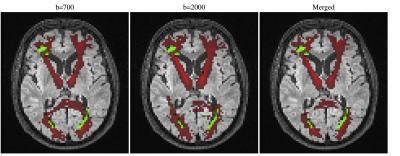Carole Hélène Sudre1,2, Chiara Maffei3, Josephine Barnes2, David Thomas2, David Cash2, Tom Parker2, Chris Lane2, Marcus Richards2, Hui Zhang2, Sebastien Ourselin1, Jonathan Schott2, Anastasia Yendiki3, and M. Jorge Cardoso1
1King's College London, London, United Kingdom, 2University College London, London, United Kingdom, 3Massachusetts General Hospital, Boston, MA, United States
1King's College London, London, United Kingdom, 2University College London, London, United Kingdom, 3Massachusetts General Hospital, Boston, MA, United States
Diffusion metrics extracted from multishell acquisition
correlate strongly with white matter hyperintensities along reconstructed tracts.
Changes to the diffusion signal are consistently observable in the direct
vicinity of lesions.


